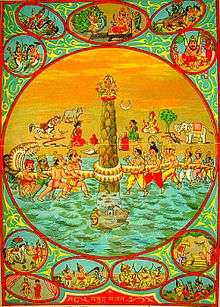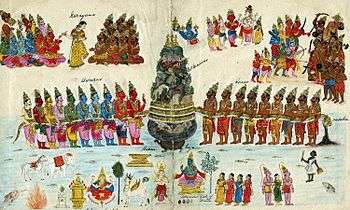Samudra manthan
Samudra manthan (Sanskrit: समुद्रमन्थन, lit. churning of the ocean) is one of the best known episodes in Hindu mythology. The story appears in the Bhagavata Purana, the Mahabharata and the Vishnu Purana, and explains the origin of amrita, the drink of immortality.
Different names
- Sāgara manthana (सागरमन्थन) - Sāgara is another word for Samudra, both meaning an ocean or large water body.
- Kshirasāgara manthana (क्षीरसागरमन्थन) - Kshirasāgara means the ocean of milk. Kshirasāgara = Kshira (milk product) + Sāgara (ocean or sea).
Legend

Indra, the King of Devas (gods), while riding on the elephant Airavata, came across Sage Durvasa who offered him a special garland given to him by the God Shiva. Indra accepted the garland and placed it on the trunk of the elephant as a test to prove that he was not an egoistic god. The elephant, knowing that Indra had no control over his own ego, threw the garland to the ground. This enraged the sage as the garland was a dwelling of Sri (fortune) and was to be treated as a prasada or religious offering. Durvasa cursed Indra and all devas to be bereft of all strength, energy, and fortune.[1]
In battles following the incident, the Devas were defeated and Asuras (demons) led by King Bali, gained control of the universe. Devas sought help from the Supreme God Vishnu who advised them to treat asuras in a diplomatic manner. Devas formed an alliance with asuras to jointly churn the ocean for the nectar of immortality and to share it among them. However, Vishnu told the Devas that he would arrange that they alone obtain the nectar.
The churning of the Ocean of Milk was an elaborate process. Mount Mandara or Mandar Parvat was used as the churning rod, and Vasuki, the king of serpents, who abides on Shiva's neck, became the churning rope. The demons demanded to hold the head of the snake, while the gods, taking advice from Vishnu, agreed to hold its tail. As a result the demons were poisoned by fumes emitted by Vasuki. Despite this, the gods and demons pulled back and forth on the snake's body alternately, causing the mountain to rotate, which in turn churned the ocean. When the mountain was placed on the ocean, it began to sink. Vishnu, in the form of a turtle Kurma, came to their rescue and supported the mountain on his back.
The Samudra Manthan process released a number of things from the Ocean of Milk. One was the lethal poison known as Halahala, which in some versions of the story, escaped from the mouth of the serpent king as the demons and gods churned. This terrified the gods and demons because the poison was so powerful that it could destroy all of creation. Then the gods approached Shiva for protection. Shiva consumed the poison in an act to protect the universe, and his wife Parvati grabbed Shiva's throat in an effort to prevent him from swallowing the poison, which was the most deadly poison in existence, harmful even to a god. As a result, Shiva's throat turned blue. For this reason, Lord Shiva is also called Neelakantha (the blue-throated one; "neela" = "blue", "kantha" = "throat" in Sanskrit).
Ratnas

All kinds of herbs were cast into the ocean and fourteen Ratnas (gems or treasures) were produced from the ocean and were divided between asuras and gods. Though usually the Ratnas are enumerated as 14, the list in the scriptures ranges from 9 to 14 Ratnas. Most lists include:[2] According to the quality of the treasures produced, they were accepted by Vishnu, the devas, and the asuras. There were three categories of Goddesses which emerged from the ocean;
- Lakshmi, the Goddess of Fortune and Wealth - who accepted Vishnu as Her eternal consort.
- Apsaras, various divine nymphs like Rambha, Menaka, Punjisthala etc. - chose the demigods as their companions
- Varuni - taken - somewhat reluctantly (she appeared dishevelled and argumentative) - accepted the demons.
Likewise, three types of supernatural animals appeared;
- Kamadhenu or Surabhi (Sanskrit:kāmadhuk), the wish-granting divine cow - taken by Vishnu, and given to sages so ghee from her milk could be used for Yajna and similar rituals.
- Airavata, and several other elephants, taken by Indra, leader of the Deva.
- Uchhaishravas, the divine 7-headed horse - given to the indra.
There were three valuables;
- Kaustubha, the most valuable Ratna in the world, worn by lord Vishnu.
- Parijat, the divine flowering tree with blossoms that never fade or wilt - taken to Indraloka by the Devas.
- Sharanga, A powerful bow - symbolic of the demon's belligerence.
Additionally produced were;
- Chandra, the moon which adorned Shiva's head
- Dhanvantari, the Vaidya of the Deva's with Amrita the nectar of immortality. (At times, considered as two different Ratna)
- Halahala, the poison swallowed by the lord Shiva.
This list varies from Purana to Purana and is also slightly different in the epics, the Ramayana and Mahabharata. Lists are completed by adding the following Ratna:[2]
- Shankha Vishnu's conch
- Jyestha - the goddess of misfortune
- The umbrella taken by Varuna
- The earrings given to Aditi, by her son Indra
- Kalpavriksha plant
- Nidra or sloth
The nectar of immortality

Finally, Dhanvantari, the heavenly physician, emerged with a pot containing Amrita, the heavenly nectar of immortality. Fierce fighting ensued between Devas and Asuras for the nectar. To protect the nectar from Asuras, the divine Garuda took the pot, and flew away from the battle-scene.
The Devas appealed to Vishnu, who then took the form of Mohini and as a beautiful and enchanting damsel, Mohini distracted the asuras, took the amrita, and distributed it among the Devas, who drank it. Asura RahuKetu, disguised himself as a deva and drank some nectar. Due to their luminous nature, the sun god Surya and the moon god Chandra noticed the switching of sides. They informed Mohini. But before the nectar could pass his throat, Mohini cut off his head with her divine discus, the Sudarshana Chakra. But as the nectar had gone down his throat he did not die. From that day, his head was called Rahu and body was called Ketu. Later Rahu and Ketu became planets. The story ends with the rejuvenated Devas defeating the asuras.
Origin of the Kumbh Mela
The medieval Hindu theology extends this legend to state that while the Devas were carrying the amrita away from the Asuras, drops of amrita fell at four places on the Earth. In one version of the legend, the carrier who spills the amrita is the divine physician Dhanavantari, who stops at four places on the Earth. In other re-tellings, the carrier who spills the amrita is either Garuda, Indra or Mohini. The four places where the amrita was spilled were: Haridwar, Prayag (Allahabad), Trimbak (Nashik) and Ujjain.[3] According to the legend, these four places acquired a certain mystical power and spirituality. A Kumbh Mela is celebrated at the four places every twelve years for this reason. People believe that after bathing there during the Kumbha mela, one can attain moksha (salvation).
While several ancient texts, including the various Puranas mention the samudra manthan legend, none of them mentions spilling of the amrita at four places.[3][4] Neither do these texts mention the Kumbh Mela. Therefore, multiple scholars, including R. B. Bhattacharya, D. P. Dubey and Kama Maclean believe that the samudra manthan legend has been applied to the Kumbh Mela relatively recently, in order to show scriptural authority for the mela.[5]
Comparative mythology
The Hindu myth has been analyzed comparatively by Georges Dumézil, who connected it to various Indo-European myths and even the European medieval legend of the Holy Grail, reconstructing an original myth (the "ambrosia cycle", or "cycle of the mead") about a trickster deity who steals a drink of immortality for mankind but fails in freeing humans from death. Dumézil later abandoned his theory, but the core of the idea was taken up by Jarich Oosten, who posits similarities with the Hymiskviða. In this Old Norse poem, a sacred mead is prepared by cooperating gods and giants (corresponding to devas and asuras, respectively), with the gods ultimately winning the drink. The serpent Jörmungandr takes the place of Vasuki (although its role in the story is different), and the two myths share themes of competition between men, sharing by women.[6]
References
- ↑ Story of Maha Kumbh Mela from Srimad Bhagvatam
- 1 2 Wilson, Horace Hayman (1840). The Vishnu Purana.
- 1 2 Kama MacLean (August 2003). "Making the Colonial State Work for You: The Modern Beginnings of the Ancient Kumbh Mela in Allahabad". The Journal of Asian Studies. 62 (3): 873–905. doi:10.2307/3591863. JSTOR 3591863.
- ↑ Arvind Krishna Mehrotra (2007). The Last Bungalow: Writings on Allahabad. Penguin. p. 289. ISBN 978-0-14-310118-5.
- ↑ Kama Maclean (28 August 2008). Pilgrimage and Power: The Kumbh Mela in Allahabad, 1765-1954. OUP USA. pp. 88–89. ISBN 978-0-19-533894-2.
- ↑ Mallory, J. P. (1997). "Sacred drink". In Mallory, J. P.; Adams, Douglas Q. Encyclopedia of Indo-European Culture. Taylor & Francis. p. 538.
External links
| Wikimedia Commons has media related to Samudra manthan. |
- The story of the churning as found in the Mahabharata
- The story of the churning as found in the Vishnu Purana
- The story of the churning as found in the Ramayana
